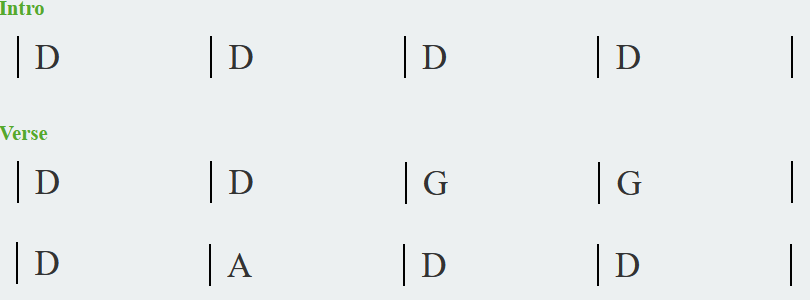Adaptive Guitar teaching method
This teaching method for the Adaptive Guitar and Switch Guitar was created in collaboration with Freek Just Rijna from from StringKick and is based on the English article 7 Essential Strumming Patterns.
The Adaptive guitar is tuned in D (D A D F# A D).
For this teaching method, 90 usable songs were first collected, all of which consist of a maximum of three chords: D, G and A. You can download a PDF overview of all songs here: SONGS in D adapted guitar.
We use this website find suitable songs: https://www.chordgenome.com/
Teaching method for the Adaptive guitar
Playing rhythm guitar can feel a bit unnatural at first. But with the right hitting technique and the right exercises it becomes more and more natural and easier.
We’ll start with a few important technique and timing tips that will make strumming patterns a lot easier. Then you will learn step by step how to learn new strumming patterns.
TABLE OF CONTENTS
PART 1 Strumming Technique and Timing Tips
PART 2 How to Learn a New Strum Pattern
PART 3 Seven Strum Patterns

Part 1 Guitar Strumming Technique and Timing Tips
With the right technique and approach, strumming will be easier and sound infinitely better. Here are the most important strumming tips you need to know.

1. Never stop moving your strumming hand
Keep your strumming hand moving at all times, even when you’re not hitting any strings for a couple of beats. By doing this, you don’t have to think about when you need to move your strumming hand: it’s moving all the time. Constantly moving your hand also makes it much easier to keep time. We’ll take a closer look at how this works later in this guide.
2. Keep a loose wrist
Make sure you’re not locking your wrist: you need to keep it nice and loose. Most of the movement will come from rotating your lower arm (you could also say: twisting your wrist) and letting your hand and wrist hang loose and follow that motion. You might be tempted to make the up and down movement with your lower part of your arm (your forearm), but though your lower arm will be moving up and down a little bit as well, that’s only a small part of the movement.

3. Keep a light grip on your (thin) pick
It’s totally normal to want to hold on to the pick tightly, because you don’t want it to move and you don’t want to drop it. But by gripping it too tight, you make it hard for the pick to move past the strings smoothly and it might get caught up in there somewhere. Also: it’s really hard to keep your wrist nice and loose when your gripping your pick tightly. By holding your pick with a light grip, you allow it to glide over the strings easily.
If you’re not used to playing with a pick, it can really help to practice with a thin pick that’s nice and bendy. As you progress, try thicker picks too though, as they’ll give you a bit more control over your sound.
 4. Don’t hit all the strings with every strum
4. Don’t hit all the strings with every strum
You might think we need to hit all the notes in a chord with every strum, but very often we hit just three or four strings. So which strings should you be hitting? A good rule of thumb is to hit either all of the strings or just the lower (thicker) strings on every downstrum. Then on the upstrum, hit only the highest (thinnest) three or four strings. This approach will make the downstrums sound a bit heaver and give your upstrums a bit of a lighter sound. And: it’ll be a little easier to play!
Deel 2 How to Learn Strum Patterns

When you hear a great song, you’ll often start tapping your foot or nodding your head to the music without even realising it. The rhythm is just so catchy or compelling that you can’t help but feel it throughout your body. This is your innate sense of rhythm kicking in. When you’re strumming, you want to tap into that innate sense of rhythm as well. That’s what will make strumming feel easy and natural.
Experienced musicians do this automatically. It’s why they’ll say things like ‘just play what you feel’ or ‘I never think about strumming, I just do it’. Of course, once upon a time, strumming was hard for them too! It’s just too long ago for them to remember. Strumming is a lot like riding a wheelchair. It takes a bunch of practice at first, but once things click, it feels like the easiest thing in the world.
So, how exactly do you go about using your natural sense of rhythm to strum a guitar? Let’s take a look at how you should learn a strum pattern, step by step!
Next, let’s take the simplest strum rhythm possible as an example.
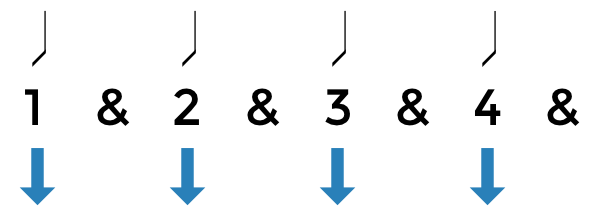
As you can see, we need to strum on each beat. So, how exactly would we get rhythm like this into our system? Here’s a three step plan!
STEP 1: “SAY IT BEFORE YOU PLAY IT”

Strumming patterns involve strumming down and strumming up. Now, while it’s important to get this right, many players get a little caught up in the mechanics of when your strumming hand needs to go up or down. It makes them lose the connection with their natural sense of rhythm.
It’s impossible to play a rhythm without hearing what it should sound like in your head. So before you even touch your guitar and before we look at the downstrums and upstrums, we want to get the rhythm in our system. You want to be able to imagine in your mind what the strumming rhythm sounds like. You want to hear it in your head.
A great way to check if you really ‘know’ the rhythm is to sing, hum, beatbox, tap or say it out loud. In other words: say it before you play it. ‘Cause if you can’t do that, playing a solid strumming groove on guitar will be impossible.
For an example of how to do this with our rhythm, check out the video below.
STEP 2: Practice the strumming rhythm on just one chord

Once you have the strumming rhythm in your mind, it’s time to start playing it. Now, when you’re learning something new, you want to focus on one thing at a time. So, you don’t want to focus on playing your new strum pattern and have to think about changing chords.
Instead, you want to play the strum rhythm on just one chord. This allows you to devote all your attention to the strumming. Below is a quick ‘one chord song’ completely played on a G chord. So grab that chord and play along!
STEP 3: Practice the strumming rhythm on a real song
Once you’re comfortable playing the strum rhythm on one chord, it’s time to try it out in a real song! The challenge here is to keep that strumming pattern going while you switch between chords too.
This tune by “The Lone Bellow” uses our ‘strum on each beat’ strum pattern, while also switching between 3 chords. See if you can play along with it! When you play the video, the right chords will automatically light up, so you know where you’re supposed to be.
Intro
Verse
Chorus
PART 3 Seven strumming patterns
In this part you will learn seven strumming patterns. The patterns are listed in order from easy to difficult. Some strokes have a play-along video so you can hear what the stroke sounds like in a ‘real’ song. Strumming patterns 5 to 7 are a bit more difficult and intended for the advanced guitarist.
Strumming pattern 1

![]()
Strumming pattern 2
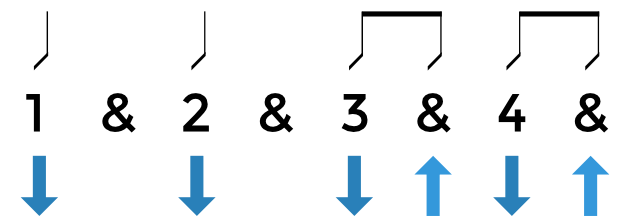
![]()
Try playing along with this song by Blake Shelton. It starts with the A chord. The guitar in the song plays a slightly different rhythm but it comes close.
Strumming pattern 3
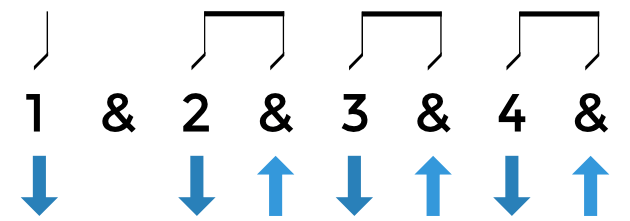

Try playing the strumming pattern along with The Cowboy Song by Ukulele Jim. It starts with the G chord.

Strumming pattern 4
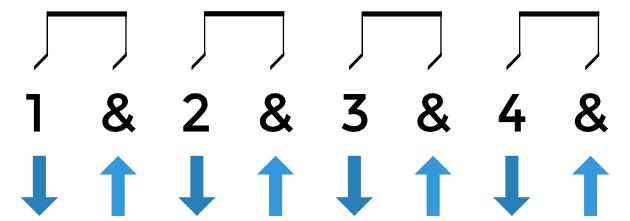

This 12 bar Blues by Tab Benoit is a very useful chord progression. The schedule starts as soon as the singing starts.
The 12 bar scheme is also widely used in Rock & Roll music.

Strumming pattern 5
De volgende 3 aanslagpatronen hebben een hoge moeilijkheidsgraad.
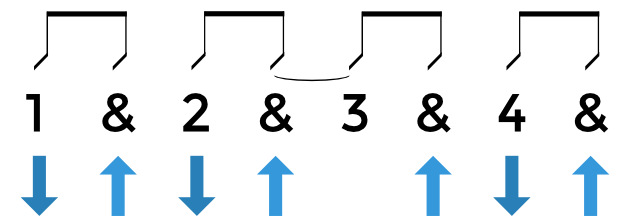
Strumming pattern 6
This strumming pattern has a high level of difficulty.
d.
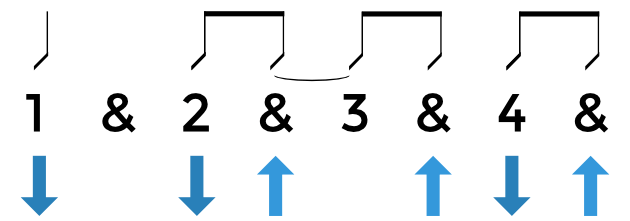
Strumming pattern 7
This strumming pattern has a high level of difficulty.
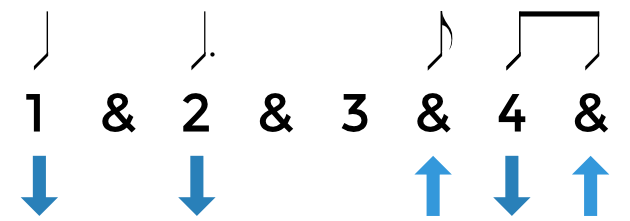
EXTRA EXERCISES
Here are some nice videos. The chord progression is below the video.
American Authors – Best Day Of My Life

Elmore James-Madison Blues

John Fogerty – Rockin’ All Over The World
